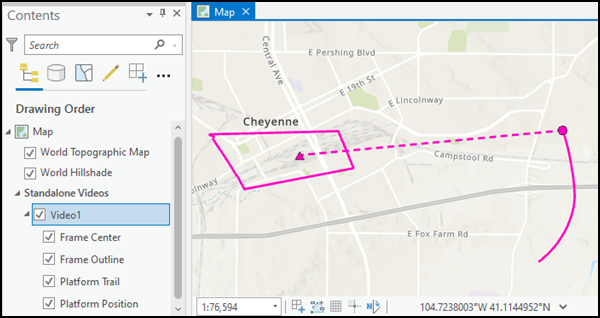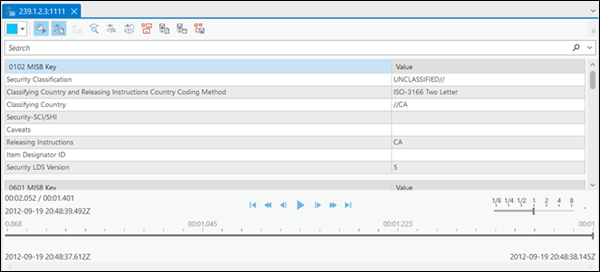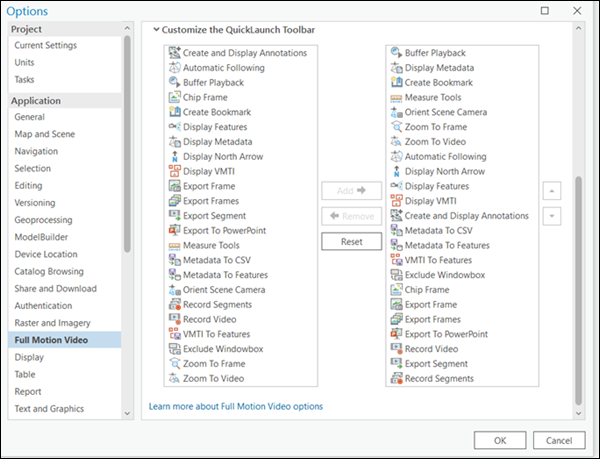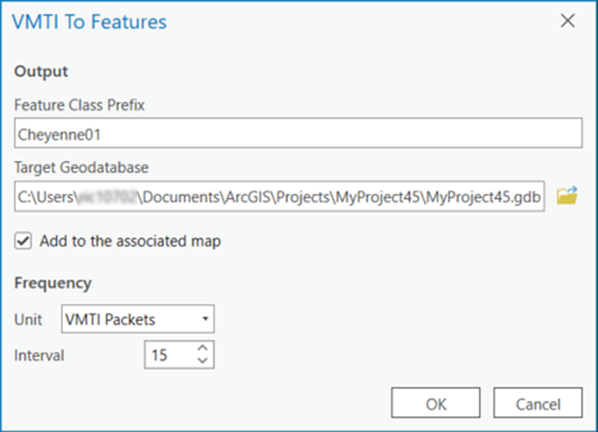Available with Image Analyst license.
Full Motion Video (FMV) in ArcGIS Pro provides the capability to work with archived and live streaming video data using a metadata viewing and analysis system called the metadata player. It works with video data that includes essential geopositional, sensor, and platform orientation information encoded into the video data stream that enables you to know where the video image is placed on a map. This unique capability gives the video important geographic context as you view and analyze the data.
The metadata player experience is similar to the ArcGIS Pro map viewer and can be moved anywhere on your display, resized, minimized, and closed.
FMV and the Metadata player
The characteristics of FMV-compliant video data and ArcGIS Pro determine the form and functionality of the FMV metadata player. These characteristics, and how they affect the FMV metadata player, are outlined below:
- The FMV-compliant video data contains camera-pointing information, platform position and attitude, and other data that is encoded into the video stream so that each video frame is associated with geopositional information.
- The metadata player is linked to the map display, enabling the following:
- Display the video footprint, sensor location, and field of view on the map.
- Update the map to zoom to the video frame, or follow videos across the map.
- The metadata player display and map display are linked with a bidirectional image and map coordinate transformation. Thus, any information collected in the metadata player is projected and displayed on the map, together with your existing GIS data.
- Any number of metadata players can be opened and played at the same time. Each video, and its associated graphical information, is identified by a unique color when displayed on the map.
- Work with live streams and archived videos.
- Use intuitive playback controls.
- Display metadata in real time as the metadata plays.
The Contents pane
When you add a video file to the Map, the video file is listed in the Contents pane. Also listed are the individual elements associated with the video, including Frame Center, Frame Outline, Platform Trail, and Platform Position. Check the check boxes next to the elements in the Contents pane to display them in the map view. For details about the video file, right-click on the video file in the Contents pane and select Properties. Details about video files are presented for the Data Source, Program Information, Frame Information, Stream Metadata - Video Stream, and Data Stream.

Note:
Once the elements are checked or unchecked, it may be necessary to select play in the metadata player to update them in the Map.Select Data Source in the Contents pane to expand video files and display KLV stream elements. You can toggle the KLV stream display on and off when the video source has one or more KLV streams. Uncheck the KLV stream to toggle off the KLV data from processing. By selecting the check box, KLV elements can be enabled/disabled for view on the map. When using Metadata to CSV or Metadata to Features, the checked KLV stream passes data to the export process. If no KLV elements are checked, or if they are disabled, the viewer will maintain the last known data, and the file will continue to play without updating the map.
The supported video formats are listed in the following table:
| Description | Extension |
|---|---|
MPEG-2 Transport Stream | .ts |
MPEG-2 Program Stream | .ps |
MPEG File | .mpg |
MPEG-2 File | .mpg2 |
MPEG-2 File | .mp2 |
MPEG File | .mpeg |
VLC (mpeg2) | .mpeg2 |
MPEG-4 Movie | .mp4 |
MPEG-4 File | .mpg4 |
MPEG-Dash | .mpd |
H264 Video File | .h264 |
VLC Media File (mpeg4) | .mpeg4 |
VLC Media File (vob) | .vob |
HLS (Adaptive Bitrate (ABR)) | .m3u8 |
To play an archived video file, browse to the video file and add it to the Contents pane or the display. Right-click the video name and select the Metadata Player option. The metadata player will open with the video file loaded. The metadata player can be moved and placed anywhere on your display. It can be resized by grabbing and moving a corner or edge of the player.

Choose a color to identify the video file and associated graphics—such as video footprint—on the map, and feature class data you want to collect on the video. You can filter the metadata being displayed by field name and value while the video is playing using the search bar.
Control playing of the video in the Metadata player
If multiple metadata players are open, the active player will be controlled by the keyboard shortcut keys.
Player controls
The metadata playback controls are outlined in the following table:
| Control | Label | Description |
|---|---|---|
 | Play | Plays the metadata according to the frames per second rate of the video. After clicking Play, the control changes to the Pause control while the metadata plays. |
 | Pause | Pauses the metadata. After clicking Pause, the control changes to the Play control while the metadata is paused. |
 | Step Forward | Steps the metadata forward by a number of seconds or frames defined on the FMV toolbar. |
 | Step Backward | Steps the metadata backward by a number of seconds or frames defined on the FMV toolbar. |
 | Fast Forward | Fast-forwards the metadata based on the playback rate of the metadata player. The speed increments by a whole number each time Fast Forward is clicked. Playback speed is reset to 1x when the player is paused or stopped. |
 | Rewind | Rewinds the metadata based on the playback rate of the metadata player. The speed increments by a whole number each time Rewind is clicked. Playback speed is reset to 1x when the player is paused or stopped. |
 | Jump to End | Jumps to the end of the metadata. |
 | Jump to Start | Jumps to the beginning of the metadata. |
You can search the metadata fields by keyword search while the video file is playing.
Video frame information display
Information about each video frame is displayed in the metadata player in real time as the archived video is played.

| Information display | Description |
|---|---|
1—Video playback slider handle | The video playback slider handle indicates the relative location within the video timeline being displayed in the metadata player. The video playback slider handle can be grabbed with a left-click and moved along the playback slider. |
2—Metadata Timestamp | The coordinated universal (UTC) time stamp in human-readable format is displayed as the video plays. This time stamp reflects the position of the video slider along the video file timeline. Click to update the jump to time stamp functionality. |
3—Video play time position | Displays the time of the current video frame relative to the total time of the video file. Time is displayed in 12-hour format. |
4—Video start time | The date and time at the start of the video file. |
5—Video end time | The data and time at the end of the video file. |
6—Adjust playback rate | Adjust the playback rate with the fine-tune slider as the video plays, and the video player will adjust and play at the new rate. |
7—Player controls | The video playback controls, such as play, pause, fast-forward and more. The playback controls are described in more detail below. |
Adjust the playback rate
You can adjust the playback rate with the Fast Forward and Rewind playback controls.
- The playback rate is indicated to the right of the playback controls.
- The playback rate reflects whole numbers.
- Click the Pause button to stop the video. The playback rate is reset to 1x.
You can adjust the playback rate with the fine-tune slider.
- The playback fine-tune slider allows fine-grained control over playback speed.
- The playback rate is a fractional number based on the slider position. The resolution is .01 second.
- The playback speed ranges from 0.01x to 8x play speed. This means that you can play a video in slow motion when playing at speeds less than 1x.
- The slow motion playback rate is reset to 1x when any of the time slider or standard playback controls are used.
Jump to time stamp
The video Metadata Timestamp (video play time display, item 2 , in the table above) reflects the time of the video slider along the video file timeline. As the metadata plays, you can right-click in the time display window to copy, cut, or paste a time stamp. When you paste a time stamp into the time display window, the metadata player will jump to that position in the video file.
Metadata player tools
In addition to the playback controls, important and useful FMV functionality is accessed from tools on the metadata player. These tools support common video analysis and management operations and workflows.
The following table lists the tools on the metadata player:
| Tool | Label | Description |
|---|---|---|
 | Display Metadata | Displays the embedded metadata. |
 | Zoom To Video | Zoom to the map location of the video. The view within the map display includes the video frame as well as the ground track of the imaging platform. |
 | Zoom To Frame | Zoom to the map location of the video’s current frame. |
 | Automatic Follow | Continuously center the map display on the video frame and ground track of the sensor as it plays. The map display will pan as the video reaches the edge of the display. To stop following the video, click the Automatic Follow video button again. |
 | Display VMTI Graphics | Display VMTI Graphics on the video and map. |
 | Metadata To Features | Save platform, frame center, and frame outline metadata as a feature class to the project's geodatabase, unless you reconfigure it in the Configure Workspace settings. |
 | Metadata to CSV | Save platform, frame center, and frame outline metadata in a comma-separated values (CSV) file. |
 | VMTI to Features | Save VMTI centerpoint data to a geodatabase. |
 | Buffer Playback | Buffering playback enables full control over video playback. |
QuickLaunch toolbar
Due to the increasing capabilities of the video and metadata player in ArcGIS Pro, there are now many controls for interacting with the video and map. Not all buttons are used by all analysts, so now you can configure the player buttons to customize the player for your instance of ArcGIS Pro.

Expand the Customize the QuickLaunch Toolbar section to establish the tools in the video player pane. Select an item in the left panel and click Add to move the item to the right panel, which displays and enables the item in the video player pane. Use keyboard shortcuts with the Customize the QuickLaunch Toolbar interface:
- R—Remove enabled buttons from list.
- A—Add a button to enabled buttons list.
Video Moving Target Indicator (VMTI)
FMV supports the display and capture of VMTI information embedded in a FMV-compliant video data stream. VMTI is a machine learning artificial intelligence method for detecting moving objects in videos. The object detection is performed and encoded into the video stream by third-party software providers, as defined in a Motion Industry Standards Board (MISB) document. If VMTI data is encoded in the FMV-compliant video, you can display the data in the video player and map as the video plays. Click the Display VMTI Graphics tool  to display rectangle graphics denoting objects identified in the video file.
to display rectangle graphics denoting objects identified in the video file.
FMV also supports object tracking using deep learning methods. See Object tracking in motion imagery for more information.
A confidence level or object identifier associated with each identified object can also be displayed in the video player and map. With the VMTI-enabled video selected in the Contents pane, click Configure Workspace on the Standalone Video > Data tab to open the Full Motion Video (FMV) Properties: Workspace dialog box. Click the VMTI category on the dialog box to specify the VMTI settings for display in the video player and map. You can specify the Confidence Level Threshold for the objects to be identified, and you can display the Confidence Level, Object Location, or Object ID label of the objects identified in the video player and map.
Click the VMTI to Features tool  to save all the objects identified in each video frame to a geodatabase. Specify the file name and location of the geodatabase, and the data capture Frequency for the objects identified. The recorded feature class data includes the centerpoint of each object detected and all the FMV metadata related to the associated video frame. The associated feature attribute table allows you to use existing geoprocessing tools to create object tracks and other statistical information for VMTI features.
to save all the objects identified in each video frame to a geodatabase. Specify the file name and location of the geodatabase, and the data capture Frequency for the objects identified. The recorded feature class data includes the centerpoint of each object detected and all the FMV metadata related to the associated video frame. The associated feature attribute table allows you to use existing geoprocessing tools to create object tracks and other statistical information for VMTI features.

If you have VMTI information in a separate file associated with a specific video, you can encode it into the video file using the FMV multiplexer. See Video Multiplexer for details.
Metadata to Features
Click the Metadata to Features tool  to save video metadata as a feature class in a geodatabase. A dialog box appears for you to specify a geodatabase and capture frequency as an interval of video frames or seconds. You can also choose to display the features on the map as they are created. The geodatabase is continuously updated while the video plays until you click the Metadata to Features tool again to disable it.
to save video metadata as a feature class in a geodatabase. A dialog box appears for you to specify a geodatabase and capture frequency as an interval of video frames or seconds. You can also choose to display the features on the map as they are created. The geodatabase is continuously updated while the video plays until you click the Metadata to Features tool again to disable it.
The sensor ground location is stored as a point feature class with the video file name appended with Camera. The video frame center is stored as a point feature class with the video file name appended with Center. The video frame outline metadata is stored as a polygon feature class with the video file name appended with Outline.
Metadata to CSV
Click the Metadata to CSV tool  to save video metadata to a comma-separated values (CSV) file. A dialog box appears allowing you to save the CSV to the project's geodatabase, or save it to a separate directory. The CSV file will contain all the MISB metadata encoded into the video stream. Click the tool again to stop the recording of the video metadata to a CSV file.
to save video metadata to a comma-separated values (CSV) file. A dialog box appears allowing you to save the CSV to the project's geodatabase, or save it to a separate directory. The CSV file will contain all the MISB metadata encoded into the video stream. Click the tool again to stop the recording of the video metadata to a CSV file.
Play a live video stream
To play a live video stream, and onlyview the metadata stream, you will need either the User Datagram Protocol (UDP) or Real Time Streaming Protocol (RTSP) address of the video stream.
Note:
The Full Motion Video player supports Internet Protocol version 4 (IPv4) addresses and both the UDP and the RTSP. MPEG TS streams can be broadcast as UDP unicast or multicast and can include MPEG-1, MPEG-2, and H.264 video decoding, and KLV metadata parsing. RTSP playback is supported for live RTSP streams that use any of the following video codecs: MPEG-1 Video, MPEG-2 Video, H.264, and MJPEG.
HTTP Live Streaming (HLS) is supported to load and play back .m3u8 files. HLS is an HTTP-based adaptive bitrate streaming communications protocol used in media players, web browsers, streaming media servers, and mobile devices.
When you have verified that your broadband connection is operating, add a live stream video to the map display from the Map tab, click the Add Data drop-down menu, then click Data from Path, which opens the Add Data From Path dialog box, where you enter the UDP or RTSP address of the video stream and click Add. The live stream video is loaded into the video player and begins to play. Locate the video name in the Contents pane, right click and select Metadata Player.

Buffer Playback
The video playback controls are enabled in Buffer Playback mode, which is accessed either from the video player or from the Live Stream group on the Player contextual tab. All the metadata player tools are enabled and operate the same as with an archived video file.
Click the Buffered Playback tool to enable and disable the playback mode. The live stream video is stored in a temporary file, or you can designate a storage location for saving UDP live-stream videos in the Configure Full Motion Video Workspace pane.
Keyboard shortcuts for Full Motion Video
Keyboard shortcuts allow you to work efficiently with your video data. The keyboard shortcuts perform operations on the active video player. These operations behave the same as the corresponding tools on the video player toolbar. If multiple video players are open, the active player will be controlled by the keyboard shortcut keys.
| Keyboard shortcut | Action | Comment |
|---|---|---|
| Alt+Z | Zoom to frame. | The view within the map display includes the video frame, as well as the ground track of the imaging platform. This is the same as the Zoom to Video video player tool. |
| F | Enable or disable Automatic Follow. | Continuously center the map display on the video frame and ground track of the sensor as it plays. The map display pans as the video reaches the edge of the display. This is the same as the Automatic Follow video player tool. |
| Z | Zoom the video pane to the map location of the video. | The view within the map display includes the video frame, as well as the ground track of the imaging platform. This is the same as the Zoom to Video tool in the video player. |
| V | Display VMTI. | Display VMTI graphics on the video and map. |
| Shift +M | Metadata to Features. | Save platform, frame center, and frame outline metadata as a feature class to the project's geodatabase, unless you reconfigure it in the Configure Workspace settings. |
| Shift+Ctrl+M | Metadata to CSV. | Save platform, frame center, and frame outline metadata in a comma-separated values (CSV) file. |
| Shift +V | VMTI to Features. | Save VMTI centerpoint data to a geodatabase. |
| Ctrl+Space | Buffer Playback | Buffering playback enables full control over video playback. |
| M | Display Metadata | Display the embedded metadata. |